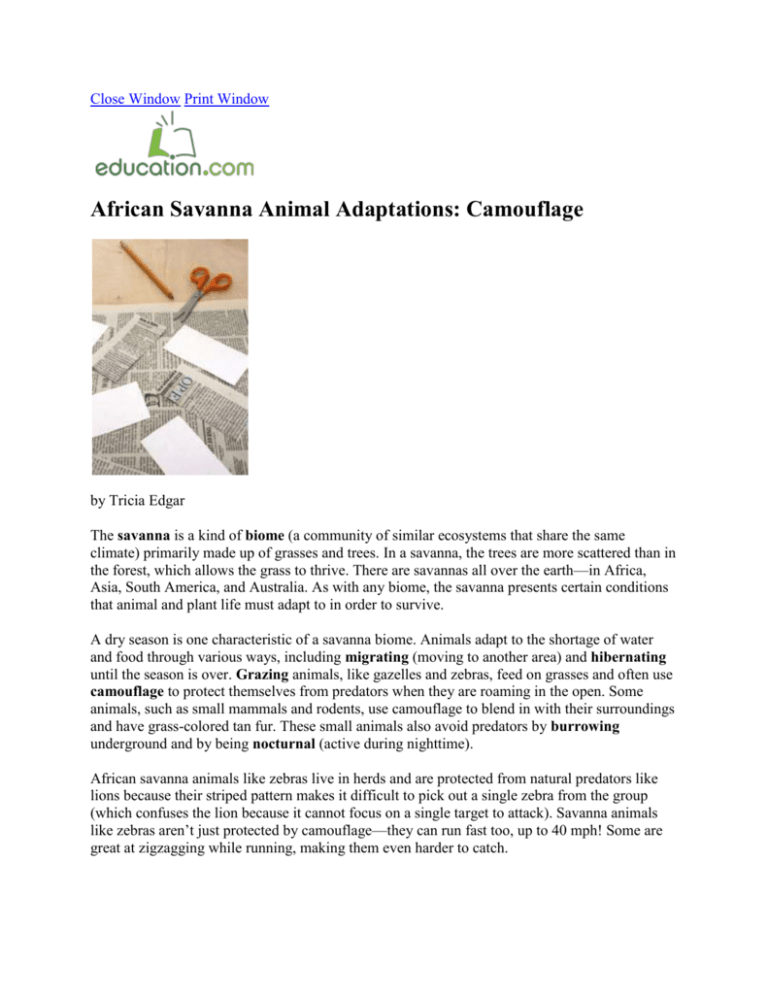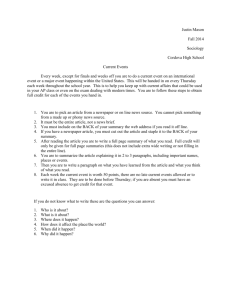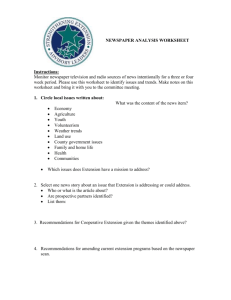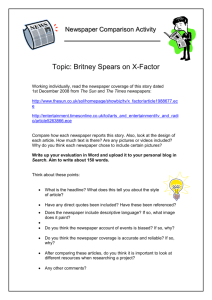
Close Window Print Window
African Savanna Animal Adaptations: Camouflage
by Tricia Edgar
The savanna is a kind of biome (a community of similar ecosystems that share the same
climate) primarily made up of grasses and trees. In a savanna, the trees are more scattered than in
the forest, which allows the grass to thrive. There are savannas all over the earth—in Africa,
Asia, South America, and Australia. As with any biome, the savanna presents certain conditions
that animal and plant life must adapt to in order to survive.
A dry season is one characteristic of a savanna biome. Animals adapt to the shortage of water
and food through various ways, including migrating (moving to another area) and hibernating
until the season is over. Grazing animals, like gazelles and zebras, feed on grasses and often use
camouflage to protect themselves from predators when they are roaming in the open. Some
animals, such as small mammals and rodents, use camouflage to blend in with their surroundings
and have grass-colored tan fur. These small animals also avoid predators by burrowing
underground and by being nocturnal (active during nighttime).
African savanna animals like zebras live in herds and are protected from natural predators like
lions because their striped pattern makes it difficult to pick out a single zebra from the group
(which confuses the lion because it cannot focus on a single target to attack). Savanna animals
like zebras aren’t just protected by camouflage—they can run fast too, up to 40 mph! Some are
great at zigzagging while running, making them even harder to catch.
However, carnivores use camouflage and speed to survive too. Cheetahs have a spotted pattern in
their tan coat to help hide them while they’re stalking prey, and can also run up to 65 mph (and
accelerate 7 mph each stride)!
Let’s test your friend’s predatory abilities and see if the animal adaptation of camouflage really
does help animals, like those that live in the savanna, escape detection!
Problem:
How easily can people see hidden, camouflaged pieces of paper?
Materials
Pencil
Scissors
2 sheets of newspaper with text only
3-5 sheets of colored construction paper
Friend
Procedure
1. Do your friends have super-duper predator vision? In nature, animals sometimes hide on
backgrounds that look like them. This is called camouflage. In this experiment, you’ll test
your friend to see whether he can see camouflaged pieces of paper.
2. First, get a big piece of newspaper. This is your background for the experiment. It’s
where you’ll hide the other pieces of paper.
3. Next, cut pieces of the different colors of construction paper into rectangles that are 2
inches high and 4 inches wide. Make five of these pieces.
4. Now cut five pieces out of a second piece of newspaper. These rectangles should be the
same size as the pieces of copy paper. Avoid pieces with photos on them.
5. Put the big piece of newspaper on the floor, and arrange the squares of colored paper and
newspaper on the big piece of newspaper.
6. Create a hypothesis, your best guess as to what is going to happen. How many rectangles
will your friend see?
7. Bring your friend into the room with his eyes closed. Get him to look at the newspaper
for a second, then turn around and report to you. How many rectangles did he see?
8. What would happen if you let your friend look for a longer amount of time? How long
does it take him to see all of the rectangles?
Results
Your friend will see the colored pieces of paper before he sees the newspaper.
Why?
Think about the newspaper squares as the camouflaged animal, and the full sheet of newspaper
as the surroundings. The newspaper squares were difficult to spot because they blend in to the
background, and the colored construction paper squares are what your eyes are drawn too. The
same goes for animals in the savanna; the animals that are camouflaged do not draw attention to
themselves and can escape notice by predators (or prey).
You can also relate the newspaper to a zebra herd, and the newspaper squares to individual
zebras—they’re tough to pick out. Imagine that the herd is running as a group to escape a
predator. It’s enough to make you dizzy!
Some animals take camouflage beyond patterns. They actually look like something in their
environment. Stick and leaf insects are great examples of this kind of mimicry. They look like
real sticks and leaves so they can easily hide in the forest. However, some animals, like poison
dart frogs, have adapted to be brightly-colored and stand out in their surroundings. These bright
colors scare off predators because they indicate that the animal is poisonous (sometimes brightlycolored animals aren’t poisonous, but use this as a bluff).
Can you think of any ways to make this experiment harder? You can even try making some
camouflage to wear yourself and see if your friend can find you!
© Copyright 2006-2012 Education.com All Rights Reserved.
http://www.education.com/science-fair/article/savanna-animal-survivors/







